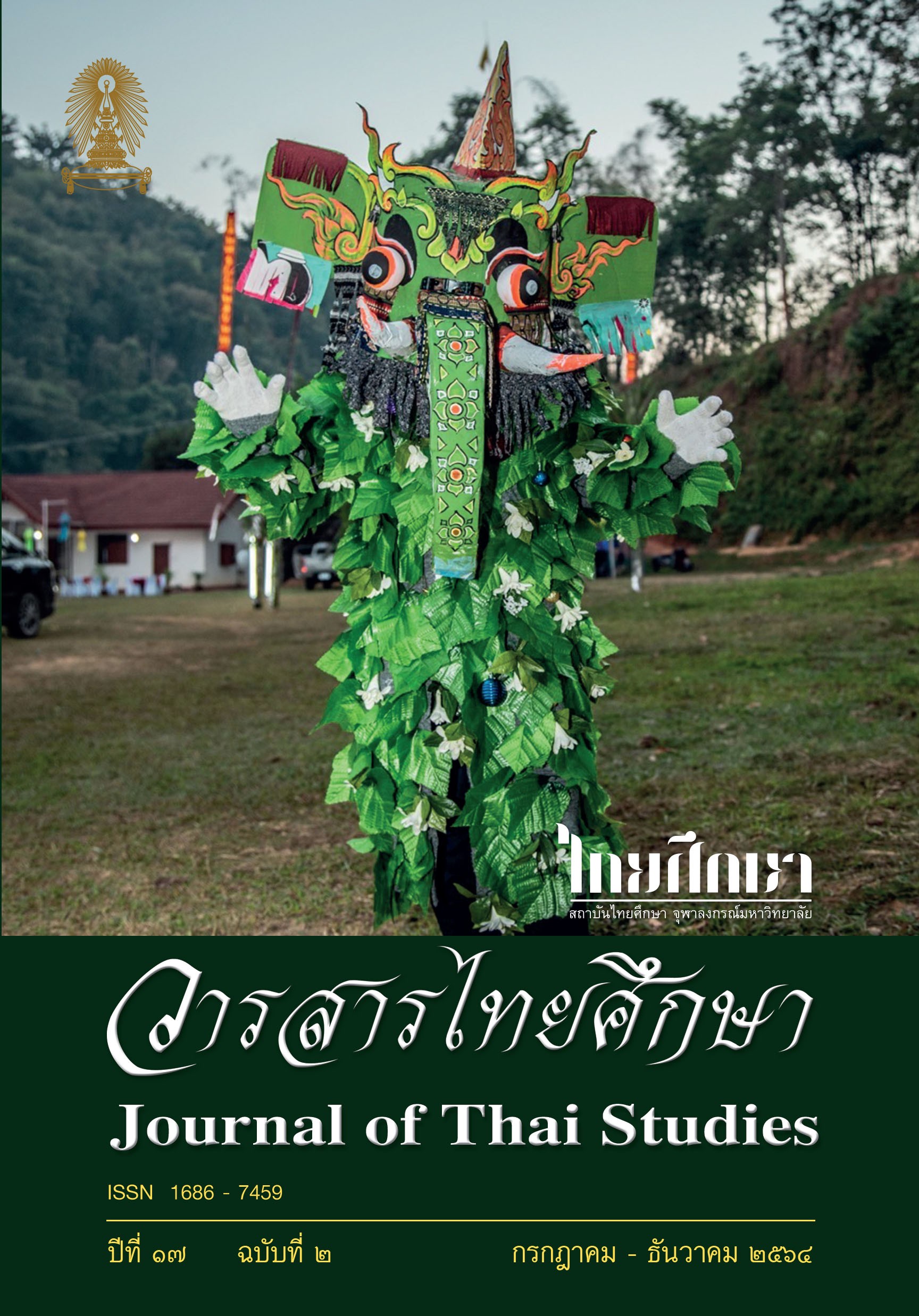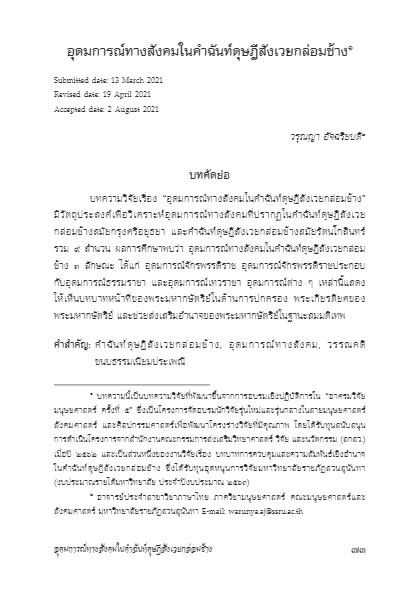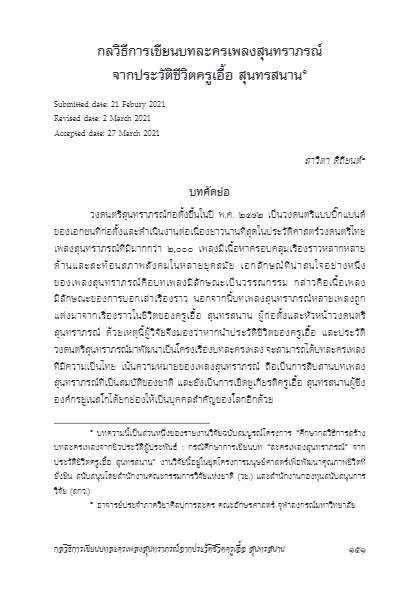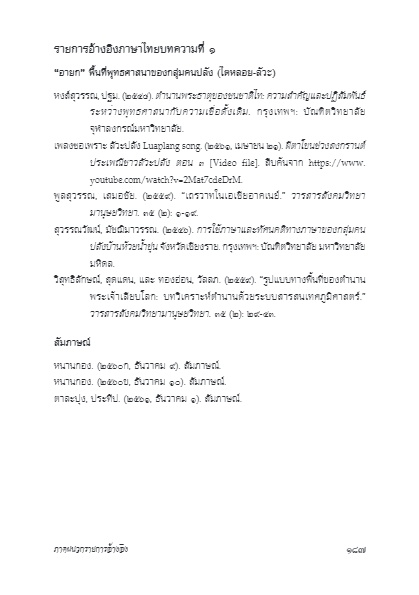วารสารไทยศึกษาปีที่ 17 ฉบับที่ 2

1) "อายก" พื้นที่พุทธศาสนาของกลุ่มคนปลัง (ไตหลอย-ลัวะ) / พลวัต ประพัตน์ทอง เชิดชาติ หิรัญโร พวงผกา ธรรมธิ
2) การเปลี่ยนแปลงของวัดไทยสามัคคีตำบลแม่กาษา อำเภอแม่สอด จังหวัดตาก เพื่อรองรับการท่องเที่ยวเชิงศาสนา / ศิริวรรณ มูลใจ แคทรียา อังทองกำเนิด
3) บทบาทการสร้างสรรค์และการสืบทอดมรดกภูมิปัญญาทางวัฒนธรรมล้านนาของพระราชชายาเจ้าดารารัศมี/ ภักดีกุล รัตนา ไพโรจน์ ไชยเมืองชื่น
4) อุดมการณ์ทางสังคมในคำฉันท์ดุษฎีสังเวยกล่อมช้าง / วรุณญา อัจฉริยบดี
5) "โลกอัปลักษณ์" : การถูกกดทับและการหลีกหนีของตัวละครอาชญกร ในอาชญนิยายชุด พุ่มรัก พานสิงห์ ของ วินทร์ เลียววาริณ / สุพิชญา ขัตติยะมาน น้ำผึ้ง ปัทมะลางคุล
6) ช้างบิน และ กล่องตุ๊กตาใสกับจดหมายของพ่อ : ความตายในวรรณกรรมเยาวชนรางวัลแว่นแก้ว / วรัชยา เลี่ยวเทียนไชย น้ำผึ้ง ปัทมะลางคุล
7) กลวิธีการเขียนบทละครเพลงสุนทราภรณ์ จากประวัติชีวิตครูเอื้อ สุนทรสนาน / สาวิตา ดิถียนต์
“อายก” พื้นที่พุทธศาสนาของกลุ่มคนปลัง(ไตหลอย-ลัวะ)
“อายก” พื้นที่พุทธศาสนาของกลุ่มคนปลัง(ไตหลอย-ลัวะ)
พลวัฒ ประพัฒน์ทอง
เชิดชาติ หิรัญโร
พวงผกา ธรรมธิ
บทคัดย่อ
การศึกษานี้มีวัตถุประสงค์เพื่ออธิบายกลุ่มคนที่สัมพันธ์กับความเป็นชาติพันธุ์ในพื้นที่พุทธศาสนา โดยศึกษาจากงานประเพณี “อายก” ซึ่งเป็นพิธีที่มีความหมายว่าการสร้างสิ่งที่น่ากลัวเพื่อปกป้องพระศพของพระพุทธเจ้าของกลุ่มชาติพันธุ์ปลัง(ไตหลอย-ลัวะ) ในพื้นที่บ้านห้วยน้ำขุ่น ตำบลแม่ฟ้าหลวง อำเภอแม่ฟ้าหลวง
จังหวัดเชียงราย และศึกษาจากเรื่องเล่า “อายก” ในพื้นที่เมืองเชียงตุง รัฐฉานประเทศสาธารณรัฐแห่งสหภาพเมียนมา ด้วยวิธีการศึกษางานภาคสนามต่อเนื่องมาตั้งแต่ปี พ.ศ. ๒๕๔๗ และศึกษาภาคสนามแบบวงกว้างในปี พ.ศ. ๒๕๖๐ เพื่อการเปรียบเทียบ การเคลื่อนที่ของกลุ่มคนและความเปลี่ยนแปลงพื้นที่ของความหมาย
ทางพุทธศาสนากับกลุ่มคนในสภาวะชาติพันธุ์สัมพันธ์ร่วมสมัยผลการศึกษาพบว่า การเคลื่อนที่ของพุทธศาสนาเข้ามาในภาคพื้นทวีปเอเชียตะวันออกเฉียงใต้ ทำให้เกิดการสร้างวรรณกรรมพุทธศาสนาของกลุ่มคนพูดภาษาตระกูลไทในล้านนาและรัฐฉาน ดังเรื่องที่คนพื้นถิ่น (ลัวะ) เป็นผู้ได้พบเห็นพระพุทธเจ้าและเป็นผู้เก็รักษาสิ่งที่พระพุทธเจ้าประทานให้ก่อนการเกิดขึ้นของเมืองที่ประดิษฐานศาสนาพุทธ เป็นภารกิจของคนพื้นถิ่นต่อพระพุทธเจ้าก่อนกลุ่มคนพูดภาษาตระกูลไทประเพณี “อายก” เป็นพื้นที่หนึ่งทางพุทธศาสนาของกลุ่มคนปลัง (ไตหลอย-ลัวะ)ที่จัดขึ้นที่หมู่บ้านห้วยน้ำขุ่น จังหวัดเชียงราย ซึ่งเป็นหมู่บ้านที่มีความหลากหลายทาง
ชาติพันธุ์ประเพณีนี้ทำให้เห็นว่าแม้คนปลังจะถูกจัดลำดับชั้นทางสังคม ให้เป็นคนที่ยังไม่เคยมีอาณาจักรหรือรัฐ เช่น ไทใหญ่ ไทลื้อ ไทขึน แต่กลุ่มคนปลัง (ไตหลอย-ลัวะ) ก็ได้สร้างประเพณีเพื่ออธิบายตนเองว่าเป็นผู้อยู่ร่วมสมัยกับพุทธเจ้า และได้รับมอบหมายในการปกป้องพระศพของพระองค์ ซึ่งพิธีเช่นนี้นั้นในกลุ่มวัฒนธรรมล้านนา จะเรียกว่าวันอัฏฐมีบูชา ซึ่งเป็นวันถวายพระเพลิงพระพุทธสรีระของพระพุทธเจ้า แต่สำหรับคนปลัง (ไตหลอย-ลัวะ) ที่บ้านห้วยน้ำขุ่นนั้นเรียกว่า ประเพณีอายก ได้จัดขึ้นในวันเพ็ญของเดือนธันวาคมทุกปี อภิปรายผลศึกษาได้ว่า การสร้างพื้นที่ของชาติพันธุ์ในพุทธศาสนาให้กับอัตลักษณ์ทางชาติพันธุ์ในโครงสร้างสังคมที่เป็นพหุวัฒนธรรมแต่อย่างไรก็ตามตัวตนนี้ก็ยังผูกติดกับลำดับชั้นทางอุดมการณ์ทางพุทธศาสนาที่กดทับผู้คนไว้เช่นกัน
คำสำคัญ: ชาติพันธุ์, การสร้างพื้นที่ทางวัฒนธรรม, กลุ่มชาติพันธุ์ปลัง
(ตีพิมพ์ใน วารสารไทยศึกษา ปีที่ 17ฉบับที่ 2 (กรกฏาคม -ธันวาคม 2564) หน้า 1-24)
‘Ayok’: Buddhist Space of the Plang (Tai Luay or Lua) Ethnic Group
Pollavat Prapattong
Cherdchart Hirunro
Phuangphaka Thammathi
Abstract
The primary objective of this study was to explain the efforts of a
Buddhist ethnic group to establish religious-cultural space. This study focused
on the ‘Ayok’ festival of the Plang (Tai Luay or Lua) ethnic group, a festival
that involves the use of horrifying objects for the purpose of guarding the
body of the Buddha. The data for this study, collected through an on-going
field study dating back to 2004 and through additional broad-scale fieldwork
in 2017, were from two sources: (i) the Plang community in Huay Nam Khun
village in Mae Fah Luang district/sub-distri1ct, Chiang Rai province; and (ii)
Ayok-related legends commonly told in the Shan State of the Republic of the
Union of Myanmar. The data were used to make a diachronic comparison of
the ethno-cultural dynamics and changes, in light of contemporary ethnicity,
of the Plang in their geo-cultural space within Buddhism.
According to the study, the arrival of Buddhism in mainland Southeast
Asia gave rise to the creation of literary works by some ethnic groups in the
Lanna Kingdom and the Shan State, whose native languages belonged to the
Tai family. However, according to folk legends, some natives, mostly Luas,
claimed to have seen the Buddha himself and been entrusted with the duty of
guarding his relics or objects, even before the birth of any Buddhism-dominated
community and before any similar efforts by other Tai-speaking ethnic
groups.
The Ayok Festival observed by the Plang of Huay Nam Khun, a community of high ethnic diversity, reflects that, although this ethnic group is socially classified as a kingdom-less or state-less people, along with the Shan,Tai Lue and Tai Khoen, the Plang, nonetheless, have developed a traditionexplaining that their ancestors lived during the same period as the Buddha,
and, therefore, were appointed guardians of his body. This tradition, known as the Buddha Cremation Memorial Day (usually in May) amongst Lanna cultures, is celebrated by the Plang of Huay Nam Khun on the full-moonnight of December. The study shows that the reason an ethnic group attempts to occupy a space in Buddhism is to solidify its presence in a multicultural
society. Nevertheless, such presence is still subjected to repression arising from Buddhist hierarchical ideology.
Keywords: Ethnicity, cultural spaces, Plang ethnic group
(Published in Journal of Thai Studies Volume 17 Number 2 (July – December 2021) Page 1-24)
บทความ/ fulltext : 1_Pollavat.pdf
การเปลี่ยนแปลงของวัดไทยสามัคคี ตำบลแม่กาษา อำเภอแม่สอด จังหวัดตาก เพื่อรองรับการท่องเที่ยวเชิงศาสนา
การเปลี่ยนแปลงของวัดไทยสามัคคี ตำบลแม่กาษา อำเภอแม่สอด จังหวัดตาก เพื่อรองรับการท่องเที่ยวเชิงศาสนา
ศิริวรรณ มูลใจ
แคทรียา อังทองกำเนิด
บทคัดย่อ
งานวิจัยนี้มีวัตถุประสงค์เพื่อรวบรวมประวัติความเป็นมา และข้อมูลเกี่ยวกับวัดไทยสามัคคี ตำบลแม่กาษาอำเภอแม่สอด จังหวัดตาก และเพื่อศึกษาการเปลี่ยนแปลงของวัดไทยสามัคคีเพื่อรองรับการท่องเที่ยวเชิงศาสนา โดยใช้วิธีการรวบรวมข้อมูลจากข้อมูลทุติยภูมิ และการเก็บข้อมูลภาคสนามจากการสัมภาษณ์เชิงลึก
และการสังเกตแบบไม่มีส่วนร่วม โดยใช้แนวคิดคติชนสร้างสรรค์มาเป็นกรอบในการศึกษา
ผลการศึกษาพบว่า วัดไทยสามัคคีสร้างขึ้นเมื่อปี พ.ศ. ๒๔๘๖ เดิมภายในวัดมีเพียงพระอุโบสถและพระวิหารสำหรับประกอบศาสนพิธี จนกระทั่งปี พ.ศ. ๒๕๕๓มีผู้สนใจเข้ามาเยี่ยมชมวัดไทยสามัคคีจำนวนมากขึ้นจึงมีการพัฒนาวัดทั้งการสร้างพระพุทธรูป รูปเคารพ ศาสนสถานตลอดจนสถานที่ต่างๆ ในด้านการเปลี่ยนแปลง
ของวัดไทยสามัคคีที่เกิดขึ้นพบว่ามีการนำคติชนในสังคมประเพณีมาปรับใช้ในวัตถุประสงค์เพื่อรองรับบริบทการท่องเที่ยวเชิงศาสนา โดยการผลิตซ้ำความเชื่อผ่านวัตถุสัญลักษณ์ และในกิจกรรมการท่องเที่ยว ๑๒ เดือนพบทั้งการสืบทอดและการผลิตซ้ำผสมผสาน และการสร้างสรรค์ประเพณีใหม่
คำสำคัญ: วัดไทยสามัคคี, การท่องเที่ยวเชิงศาสนา, คติชนสร้างสรรค์
(ตีพิมพ์ใน วารสารไทยศึกษา ปีที่ 17ฉบับที่ 2 (กรกฏาคม -ธันวาคม 2564) หน้า 25-49 )
Changes at Wat Thai Samakkhi in Mae Kasa Sub-District Mae Sot District, Tak Province to Accommodate Religious Tourism
Siriwon Moonjai
Catthaleeya Aungthongkamnerd
Abstract
This research aimed to collect historical background and information on Wat Thai Samakki at Mae Kasa Sub-district, Mae Sot District, Tak Province and to study changes made to the temple in order to accommodate religious tourism. The data was collected from secondary sources, indepth interviews conducted during a field trip and non-participant observations, employing
creative folklore as a frame of study.
The results revealed that Wat Thai Samakkhi was built in 1943. At that time, there was only a main hall (Phra Ubosot) and a meeting hall Phra Viharn) for performing rituals and ceremonies. It was not until 2010 that the temple became well-known and was visited by an increasing number
of tourists. Since then, several changes have been made to the temple,including the construction of Buddha images, statues and buildings. The research found that folk culture was directly applied to accommodate people’s need for religious trips; for example, the reproduction of traditional beliefs through symbols and material objects and the attempts to preserve cultures,blend the old and new and create new traditions in organizing a wide range of activities for tourists throughout the year.
Keywords: Wat Thai Samakkhi, Religious Tourism, Creative Folklore
Published in Journal of Thai Studies Volume 17 Number 2 (July – December 2021) Page 25-49)
บทความ/Fulltext:2_Siriwon.pdf
บทบาทการสร้างสรรค์และการสืบทอดมรดกภูมิปัญญา ทางวัฒนธรรมล้านนาของพระราชชายาเจ้าดารารัศมี
บทบาทการสร้างสรรค์และการสืบทอดมรดกภูมิปัญญาทางวัฒนธรรมล้านนาของพระราชชายาเจ้าดารารัศมี
ภักดีกุล รัตนา
ไพโรจน์ ไชยเมืองชื่น
บทคัดย่อ
บทความวิจัยนี้มีวัตถุประสงค์เพื่อศึกษาวิเคราะห์บทบาทด้านการสร้างสรรค์และการสืบทอดมรดกภูมิปัญญาทางวัฒนธรรมล้านนาของพระราชชายาเจ้าดารารัศมีการศึกษาวิจัยนี้เป็นการศึกษาเอกสาร โดยมีวิธีการเก็บรวบรวมข้อมูล คือการทบทวนเอกสารชั้นต้น และเอกสารชั้นรองที่เกี่ยวข้อง จากนั้นวิเคราะห์เอกสารทั้งหมดที่เกี่ยวกับพระราชชายาเจ้าดารารัศมี ผลการวิจัยพบว่าพระราชชายาเจ้าดารารัศมีทรงเป็นผู้มีบทบาททั้งเป็นผู้สร้างสรรค์วัฒนธรรม การสงวนรักษาและสืบทอดองค์ความรู้และวัฒนธรรมของล้านนา ซึ่งเป็นหัวใจสำคัญในกระบวนการสืบทอดมรดกภูมิปัญญาทางวัฒนธรรม บทบาทในการสร้างสรรค์และการสืบทอดมรดกภูมิปัญญาทางวัฒนธรรมของพระราชชายาเจ้าดารารัศมี แบ่งออกเป็น ๓ ด้านคือ ๑) ด้านการดนตรี การขับร้อง การละคร และการฟ้อนรำ ๒) ด้านวรรณกรรม และ ๓) ด้านประวัติศาสตร์ท้องถิ่น
คำสำคัญ: การสร้างสรรค์, มรดกภูมิปัญญาทางวัฒนธรรม, ล้านนา, พระราชชายาเจ้าดารารัศมี
(ตีพิมพ์ใน วารสารไทยศึกษา ปีที่ 17ฉบับที่ 2 (กรกฏาคม -ธันวาคม 2564) หน้า 51-72 )
The Role of Creator and Transmitter of Lanna Intellectual Cultural Heritage by Her Highness Princess Dara Rasmi
Pakdeekul Ratana
Phairot Chaimuangchun
Abstract
The purpose of the research for this article was to study the role of Her Highness Princess Dara Rasmi as the creator and the transmitter of Lanna intellectual cultural heritage. This study was documentary research. The method of data collection was to review primary and secondary sources, after which the data were analyzed using content analysis. The research found that
Her Highness Princess Dara Rasmi played a role in creating and preserving creative Lanna culture, as well as, transmitting Lanna traditional knowledge and culture, which is the core of the process of the concept of intangible cultural heritage transmission. The role of Her Highness Princess Dara Rasmi can be divided into three areas: 1) music, song, drama and dance; 2) literature; and 3) local history.
Keywords: Creativity, Cultural Heritage, Lanna, Her Highness Princess Dara Rasmi
Published in Journal of Thai Studies Volume 17 Number 2 (July – December 2021) Page 51-72)
บทความ/ fulltext :3_Pakdeekul.pdf
อุดมการณ์ทางสังคมในคำฉันท์ดุษฎีสังเวยกล่อมช้าง
อุดมการณ์ทางสังคมในคำฉันท์ดุษฎีสังเวยกล่อมช้าง
วรุณญา อัจฉริยบดี
บทคัดย่อ
บทความวิจัยเรื่อง “อุดมการณ์ทางสังคมในคำฉันท์ดุษฎีสังเวยกล่อมช้าง”มีวัตถุประสงค์เพื่อวิเคราะห์อุดมการณ์ทางสังคมที่ปรากฏในคำฉันท์ดุษฎีสังเวยกล่อมช้างสมัยกรุงศรีอยุธยา และคำฉันท์ดุษฎีสังเวยกล่อมช้างสมัยรัตนโกสินทร์รวม ๙ สำนวน ผลการศึกษาพบว่า อุดมการณ์ทางสังคมในคำฉันท์ดุษฎีสังเวยกล่อมช้าง ๓ ลักษณะ ได้แก่ อุดมการณ์จักรพรรดิราช อุดมการณ์จักรพรรดิราชประกอบกับอุดมการณ์ธรรมราชา และอุดมการณ์เทวราชา อุดมการณ์ต่าง ๆ เหล่านี้แสดงให้เห็นบทบาทหน้าที่ของพระมหากษัตริย์ในด้านการปกครอง พระเกียรติยศของ
พระมหากษัตริย์ และช่วยส่งเสริมอำนาจของพระมหากษัตริย์ในฐานะสมมติเทพ
คำสำคัญ: คำฉันท์ดุษฎีสังเวยกล่อมช้าง, อุดมการณ์ทางสังคม, วรรณคดี, ขนบธรรมเนียมประเพณี
(ตีพิมพ์ใน วารสารไทยศึกษา ปีที่ 17ฉบับที่ 2 (กรกฏาคม -ธันวาคม 2564) หน้า 73-99)
Social Ideology in Elephant Pacification Poems
Warunya Ajchariyabodee
Abstract
The research for this article aimed to analyse the social ideology that appears in nine Elephant Pacification Poems of the Ayutthaya and Rattanakosin periods. The results of this study show that characteristics of Elephant Pacification Poems include Chakravartin ideology. Chakravartin ideology, along with Dharmaraja and God King ideology, represents the role of domination by the king, the honour of the king and help promote the divine right of the power of the kings.
Keywords: Elephant Pacification Poems, Social Ideology, Literary Works, Occasioned by Tradition
(Published in Journal of Thai Studies Volume 17 Number 2 (July – December 2021) Page 73-99)
บทความ/ fulltext :4_Waranya.pdf
“โลกอัปลักษณ์” : การถูกกดทับและการหลีกหนี ของตัวละครอาชญากร ในอาชญนิยายชุด พุ่มรัก พานสิงห์ ของวินทร์ เลียววาริณ
“โลกอัปลักษณ์” : การถูกกดทับและการหลีกหนีของตัวละครอาชญากร ในอาชญนิยายชุด พุ่มรัก พานสิงห์ ของวินทร์ เลียววาริณ
สุพิชญา ขัตติยะมาน
น้ำผึ้ง ปัทมะลางคุล
บทคัดย่อ
บทความฉบับนี้มีวัตถุประสงค์เพื่อศึกษาการถูกกดทับและการหลีกหนีของตัวละครอาชญากรในอาชญนิยายชุดพุ่มรัก พานสิงห์ ของวินทร์ เลียววาริณ จำนวน๒ เล่ม ได้แก่ ฆาตกรรมจักรราศี และคดีหนอนนิยาย ผลการศึกษาพบว่าชีวิตของตัวละครอาชญากรเต็มไปด้วยการถูกกระทำด้วยความรุนแรงทั้งทางร่างกายและจิตใจ การถูกกดทับที่ตัวละครประสบสามารถจำแนกได้เป็น ๔ ลักษณะ ได้แก่การถูกกดทับด้วยสถานภาพทางสังคม การถูกกดทับด้วยกรอบความเชื่อและค่านิยมของสังคม การถูกกดทับด้วยการกดขี่ข่มเหงโดยใช้ความรุนแรง และการถูกกดทับด้วยอำนาจและความขัดแย้งทางการเมือง การกดทับลักษณะต่าง ๆ นี้ทำให้ตัวละครมีลักษณะหลีกหนีและเกิดการสร้างตัวตนใหม่ เพื่อให้สามารถมีพื้นที่ได้ใน “โลกอัปลักษณ์”ที่พวกเขาต้องเผชิญ การพยายามหลีกหนีและการสร้างตัวตนใหม่นี้จึงเป็นจุดเริ่มต้นของปัญหาทางจิตที่นำไปสู่การโต้กลับการถูกกดทับด้วยความรุนแรงจนบุคคลเหล่านี้ กลายเป็นอาชญากรในที่สุด การประกอบสร้างเรื่องในลักษณะดังกล่าวจึงทำให้อาชญนิยายทั้ง ๒ เรื่องนี้ไม่ได้เป็นเพียงบันเทิงคดีที่มอบความสนุกสนานให้แก่ผู้อ่านแต่ยังเป็นพื้นที่ สำหรับการวิพากษ์วิจารณ์ “สังคม” ซึ่งเป็นต้นตอสำคัญของปัญหาอาชญากรรมในปัจจุบันอีกด้วย
คำสำคัญ: การถูกกดทับ, การหลีกหนี, ตัวละครอาชญากร, อาชญนิยาย, พุ่มรัก พานสิงห์, ฆาตกรรมจักรราศี, คดีหนอนนิยาย, วินทร์ เลียววาริณ
(ตีพิมพ์ใน วารสารไทยศึกษา ปีที่ 17ฉบับที่ 2 (กรกฏาคม -ธันวาคม 2564) หน้า 101 -126)
“The Atrocious World”: Oppression and Escape of Criminal Characters in Win Lyovarin’s Phumrak Phansing Detective Series
Supitchaya Khattiyamarn
Namphueng Padamalangula
Abstract
The research for this article aimed to study the oppression and escape of criminal characters in Khattakamchackkarasi and Khadinonniyai, two novels in Win Lyovarin’s Phumrak Phansing detective series. The study reveals thatthe criminal characters in the stories experience various violent physical and mental oppression. Such oppression causes the characters to develop escape behaviors resulting in attempts to create new identities to survive in “The Atrocious World.” The way these characters escape reality by creating new identities is the beginnings of their psychological problems that leads them to use violence as a way to counterattack society and finally become criminals.Consequently, Khattakamchackkarasi and Khadinonniyai is not only fiction that entertains readers, but also represents a platform for criticizing society, which is a major cause of criminal problems.
Keywords: Oppression, Escape, Criminal Characters, Detective series, Phumrak
Phansing, Khattakamchackkarasi, Khadinonniyai, Win Lyovarin
(Published in Journal of Thai Studies Volume 17 Number 2 (July – December 2021) Page 101-126)
บทความ/ fulltext :
ช้างบิน และ กล่องตุ๊กตาใสกับจดหมายของพ่อ: ความตายในวรรณกรรมเยาวชนรางวัลแว่นแก้ว
ช้างบิน และ กล่องตุ๊กตาใสกับจดหมายของพ่อ:ความตายในวรรณกรรมเยาวชนรางวัลแว่นแก้ว
วรัชยา เลี่ยวเทียนไชย
น้ำผึ้ง ปัทมะลางคุล
บทคัดย่อ
บทความนี้มีวัตถุประสงค์เพื่อศึกษาการนำเสนอมโนทัศน์เกี่ยวกับความตายในวรรณกรรมเยาวชนรางวัลแว่นแก้ว ประเภทนวนิยายเยาวชน ๒ เรื่อง ได้แก่ ช้างบินของอรเกษม รอดสุทธิ และ กล่องตุ๊กตาใสกับจดหมายของพ่อ ของขจรพัฒน์สุขภัทราพิรมย์ เพราะวรรณกรรมเยาวชนรางวัลแว่นแก้วทั้งสองเรื่องนี้นำเสนอเรื่องความตายอย่างโดดเด่นและมีนัยสำคัญ ผลการศึกษาพบว่า ช้างบิน และ กล่องตุ๊กตาใสกับจดหมายของพ่อ นำเสนอแนวคิดเกี่ยวกับความตายของผู้ที่เป็นที่รักไว้ ๓ ด้าน๑. ความตายคือสัจธรรมของชีวิต ๒. ความตายคือการหลุดพ้นจากความทุกข์ และ๓. ความตายคือการเดินทางไปสู่โลกหลังความตายอันอบอุ่น การนำเสนอมโนทัศน์ความตายดังกล่าวนี้เพื่อให้ผู้อ่านเยาวชนเข้าใจชีวิต ไม่หมกมุ่นอยู่ในความเศร้าเมื่อสูญเสีย และเห็นความสำคัญของการมีชีวิตอยู่ รวมถึงแนะนำให้ผู้อ่านเยาวชนใช้ชีวิตในปัจจุบันขณะของตนให้ดียิ่งขึ้น วรรณกรรมเยาวชนรางวัลแว่นแก้วทั้งสองเรื่องจึงมีคุณค่าในการสื่อสารเรื่องความตายซึ่งเป็นเรื่องที่อธิบายยากให้ผู้อ่านเข้าใจ สามารถรับมือ และก้าวข้ามความเจ็บปวดจากความตายของคนรอบข้างได้อย่างมีเหตุผลนับเป็นงานเขียนที่ช่วยแนะนำให้เยาวชนให้สามารถก้าวข้ามปัญหาชีวิตและตระหนักความจริงของชีวิตไปพร้อมกัน
คำสำคัญ: ช้างบิน, กล่องตุ๊กตาใสกับจดหมายของพ่อ, ความตาย, วรรณกรรมเยาวชน, วรรณกรรมเยาวชนรางวัลแว่นแก้ว
(ตีพิมพ์ใน วารสารไทยศึกษา ปีที่ 17ฉบับที่ 2 (กรกฏาคม -ธันวาคม 2564) หน้า 127 -150)
Chang Bin and Klong Tukkata Sai kap Chotmai Khong Pho: Death in Waen Kaeo Awarded Young Adult Books
Warachaya Liaotianchai
Namphueng Padamalangula
Abstract
The research for this article aimed to study the concept of death prominently included in two Waen Kaeo awarded young adult novels:Chang Bin by Onkasem Rotsutthi, the 12th Waen Kaeo award-winning young adult book; and Klong Tukkata Sai kap Chotmai Khong Pho by Khachonphat Sukphatthraphirom, an honorable-mention prize in the 13th Waen Kaeo Young
Adult Book Award. The research found that these young adult fiction books present three ideas of death: 1) Death is a truth of life; 2) Death is a way to release suffering; and 3) Death is a journey to a pleasant world. The concept of death is presented to help the readers understand life, to cope with grief and loss, to value life and to live their lives better. In addition, this young
adult fiction plays a role in helping their readers understand death, which is considered a difficult topic, and to cope with death in order to overcome difficulties and to realize the truth of life.
Keywords: Chang Bin, Klong Tukkata Sai kap Chotmai Khong Pho, Young , adult literature, Waen Kaeo Young Adult Book Award
(Published in Journal of Thai Studies Volume 17 Number 2 (July – December 2021) Page 127-150)
บทความ/ fulltext :6_Warachaya.pdf
กลวิธีการเขียนบทละครเพลงสุนทราภรณ์ จากประวัติชีวิตครูเอื้อ สุนทรสนาน
กลวิธีการเขียนบทละครเพลงสุนทราภรณ์จากประวัติชีวิตครูเอื้อ สุนทรสนาน
สาวิตา ดิถียนต์
บทคัดย่อ
วงดนตรีสุนทราภรณ์ก่อตั้งขึ้นในปี พ.ศ. ๒๔๘๒ เป็นวงดนตรีแบบบิ๊กแบนด์ของเอกชนที่ก่อตั้งและดำเนินงานต่อเนื่องยาวนานที่สุดในประวัติศาสตร์วงดนตรีไทยเพลงสุนทราภรณ์ที่มีมากกว่า ๒,๐๐๐ เพลงมีเนื้อหาครอบคลุมเรื่องราวหลากหลายด้านและสะท้อนสภาพสังคมในหลายยุคสมัย เอกลักษณ์ที่น่าสนใจอย่างหนึ่งของเพลงสุน ทราภรณ์คือบทเพลงมีลักษณะเป็นวรรณกรรม กล่าวคือเนื้อเพลงมีลักษณะของการบอกเล่าเรื่องราว นอกจากนี้บทเพลงสุนทราภรณ์หลายเพลงถูกแต่งมาจากเรื่องราวในชีวิตของครูเอื้อ สุนทรสนาน ผู้ก่อตั้งและหัวหน้าวงดนตรีสุนทราภรณ์ ด้วยเหตุนี้ผู้วิจัยจึงมองว่าหากนำประวัติชีวิตของครูเอื้อ และประวัติวงดนตรีสุนทราภรณ์มาพัฒนาเป็นโครงเรื่องบทละครเพลง จะสามารถได้บทละครเพลงที่มีความเป็นไทย เน้นความหมายของเพลงสุน ทราภรณ์ ถือเป็นการสืบสานบทเพลงสุนทราภรณ์ที่เป็นสมบัติของชาติ และยังเป็นการเชิดชูเกียรติครูเอื้อ สุนทรสนานผู้ซึ่งองค์กรยูเนสโกได้ยกย่องให้เป็นบุคคลสำคัญของโลกอีกด้วย
งานวิจัยชิ้นนี้จึงมีจุดประสงค์เพื่อศึกษาประวัติของครูเอื้อ สุนทรสนานและบทเพลงสุนทราภรณ์ เพื่อนำมาเขียนเป็นบทละครเพลงสุ น ทราภรณ์ที่แสดงถึงเอกลักษณ์ของเพลงและวงดนตรีสนุ ทราภรณ์ ผู้วิจัยเริ่มต้นจากการค้นคว้า รวบรวมข้อมูลเกี่ยวกับครูเอื้อ สุนทรสนาน ประวัติวงดนตรีและบทเพลงสุนทราภรณ์ ตลอดจน
การวิเคราะห์เอกลักษณ์ของวงดนตรีสุ น ทราภรณ์เพื่อนำข้อมูลที่ได้มาใช้ในการพัฒนาบทละคร โดยผู้วิจัยได้พัฒนาบทละครโดยแบ่งเป็น ๔ ขั้นตอน ได้แก่ การวางแก่นเรื่องและประเด็นที่ต้องการนำเสนอ การวางโครงเรื่อง การสร้างตัวละคร และการเลือกใช้เพลง
ผู้วิจัยสร้างบทละครเพลงสุ น ทราภรณ์จากประวัติชีวิตครูเอื้อ สุนทรสนานโดยมีความยาวประมาณ ๒ ชั่วโมง ๓๐ นาที แบ่งเป็น ๒ องก์ ประกอบไปด้วย ๒๗ฉาก และใช้เพลงสุนทราภณ์ทั้งหมด ๔๒ เพลง บทละครเลือกใช้เพลง พระเจ้าทั้งห้ามาเป็นแกนหลักของเรื่อง และนำเรื่องชีวิตรักและการทำงานของครูเอื้อ สุนทรสนาน
มาพัฒนาเป็นโครงเรื่องหลักในแต่ละองก์ การเลือกใช้เพลงนอกจากจะใช้เพลงที่มีความเกี่ยวข้องกับชีวประวัติครูเอื้อโดยตรงแล้ว ยังคำนึงถึงเนื้อเพลงที่ถูกนำมาใช้แทนบทสนทนาในบทละคร ประเภทและจังหวะเพลงที่จะส่งผลถึงจังหวะการดำเนินเรื่องเอกลักษณ์ของเพลง สุ น ทราภรณ์ถูกนำเสนอผ่านความหลากหลายของรูปแบบเพลงภาพสังคมที่สะท้อนผ่านเพลงสุ น ทราภรณ์ในแต่ละยุด รวมถึงตัวละครที่เป็นครูเพลงและนักร้องของวงดนตรีสุนทราภรณ์ที่เป็นที่รู้จัก
คำสำคัญ: การเขียนบทละคร, บทละครเพลง, ละครเพลงไทย, สุนทราภรณ์, เพลงสุนทราภรณ์,
ละครเพลงสุน ทราภรณ์, ครูเอื้อ สุนทรสนาน
(ตีพิมพ์ใน วารสารไทยศึกษา ปีที่ 17ฉบับที่ 2 (กรกฏาคม -ธันวาคม 2564) หน้า 151 -185)
The Strategy of Creating the Suntaraporn Musical Play from Eua Sunthornsanan’s Biography
Sawita Diteeyont
Abstract
The Suntaraporn music band is a private Thai big band that was founded in 1939 and has becomes the longest continuously performing band in Thai music history. There have been more than 2,000 songs created by the band, with the contents of songs being various and reflective of Thai society during the time they were composed. One of the unique characteristics of Suntaraporn’s songs is the literary nature of the lyrics that tell a story in a dramatic way. In addition, some songs were written based on the life of Eua Sunthornsanan, the founder and leader of the band. Thus, it is possible to develop the biography of Kru Eua and history of the Suntaraporn band as the plot for a musical play in order to present the value of Suntaraporn’s music, as well as to honour Kru Eua Sunthornsanan who was granted the World Personalities award by UNESCO in 2010.
Therefore, this research aims to examine the biography of Kru Eua Sunthornsanan and analyze Suntaraporn’s music in order to create a musical play that presents the unique characteristics of his songs and the band. The study included research on Kru Eua’s personal and career life, the history of the Suntaraporn band, interpretation of Suntaraporn’s songs and an analysis of the band’s identity. The script developing process was divided into four parts: establish the main message, develop the plot, create characters and select the songs list.
The play created based on Eua Sunthornsanan’s life is approximately 2 hours and 30 minutes long, divided into two acts, consist of 27 scenes and 42 songs. The song titled Pra Chao Tang Ha was chosen as the core message of the play. The main plot was developed from a conflict in the love life and career path of Kru Eua Sunthornsanan. The songs that were based on Kru Eua’s life were primary selected to be presented in the play, along with other songs that have lyrics that fit the situation and dialogue of the characters. The type and melody of songs was also considered that could affect the rhythm of the play. The unique characteristic of Suntaraporn’s music is presented through the variety in styles of the songs, the refection of Thai society in Suntaraporn’s songs and the characters in the play inspired by the band’s well-known musicians and singers.
Keyword: Playwriting, A Musical Play, Thai Musical Theatre, Suntaraporn, Suntaraporn Songs, Suntaraporn the Musical, Eua Sunthornsanan
(Published in Journal of Thai Studies Volume 17 Number 2 (July – December 2021) Page 151-185)
บทความ/ fulltext :7_Sawita.pdf








